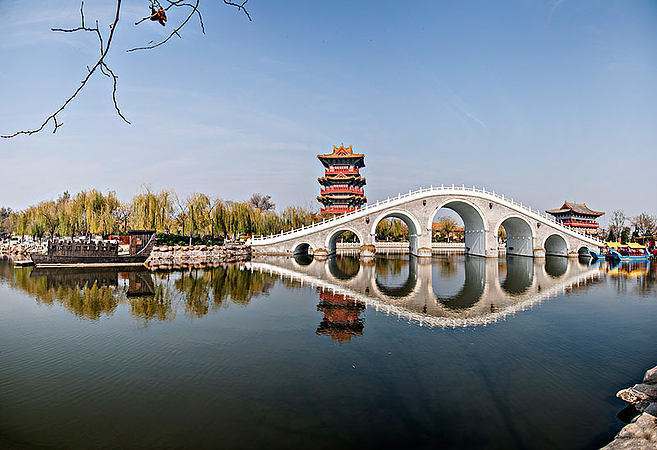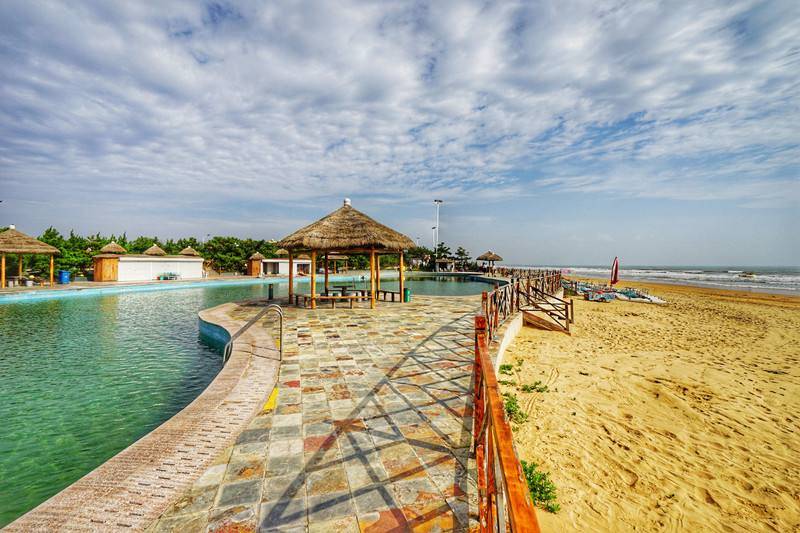The Three Confucian Sites in Qufu
The Confucius Mansion, Confucius Temple, and Confucius Forest in Qufu, Shandong, collectively known as the 'Three Confucian Sites in Qufu,' are symbols of the historical commemoration of Confucius and the promotion of Confucianism in China. They are renowned for their rich cultural heritage, long history, grand scale, abundant collection of cultural relics, and scientific and artistic value. The Confucius Temple, originally built in 478 BC, has been continuously expanded and now covers an area of 14 hectares. It is a magnificent ancient architectural complex that includes three halls, one pavilion, one altar, three shrines, two corridors, two halls, two study rooms, seventeen pavilions, and fifty-four gates and archways, making it a city of palaces with towering steles.
Linyi Yimeng Mountain Scenic Area
Mount Yimeng refers to the geographical area with Yishan and Mengshan as geological coordinates. It is now a national 5A-level tourist attraction, a national forest park, and a national geological park. It spans across Linyi, Rizhao, Weifang, and other places in Shandong, with the main area located in Linyi. Historically, Mount Yimeng belonged to the Dongyi civilization and is the site of the Great Wall of Qi, a World Cultural Heritage. Mount Meng in Shandong has an altitude of 1156 meters and is known as the 'Sub-Mount Tai'. The mountain boasts rich tourism resources, featuring unique mountain landscapes, forest landscapes, waterfall landscapes, and cultural landscapes. The scenic area is characterized by towering peaks, winding waters, and clouds, with a forest coverage rate of over 99%. It is rich in flora and fauna resources and is one of the best green fitness tourism destinations in China.
Lianyungang Huaguo Mountain
Huaguo Mountain is located in the middle of the southern Yuntai Mountain in Lianyungang City. The Huaguo Mountain Scenic Area is the core scenic area of the national Yuntai Mountain Scenic Area and a national 5A-level tourist area. The wild plant resources of Huaguo Mountain are very rich, with more than 1,700 species of plants, including 1,190 medicinal resources. Golden-thread bamboo and ancient ginkgo are rare tree species in the province and even in the country. The Water Curtain Cave, Tang Monk Cliff, and ancient famous trees are important wild plant resource banks in Jiangsu Province, attracting many domestic universities, research institutions, experts, and scholars to investigate and study every year.
Taian Fantawild Adventure is located in Taishan District, Taian City, Shandong Province, adjacent to the east side of the Taishan Scenic Area. The park covers an area of about 500,000 square meters with a total investment of 2 billion yuan. It is a world-class fourth-generation theme park. Taian Fantawild Adventure consists of 17 themed areas including Dinosaur Crisis, Fly Over Limits, Mysterious Valley, Liaozhai, Vesuvius Volcano, Conch Bay, Future Police, and Light of Life. It includes more than 300 themed projects, amusement projects, leisure, and landscape projects, many of which are world-class large-scale projects. Most of the projects are not affected by the weather, making it very suitable for family trips.
Fengyang Langxiang Migu
Langxiang Migu Scenic Area is located 30 kilometers southeast of Fengyang County, Anhui Province, covering an area of about 9 square kilometers. It is 20 kilometers from the He-Beng Highway, 25 kilometers from the He-Xu Expressway, 50 kilometers from the Beng-Ning Expressway, and 42 kilometers from the Beijing-Shanghai Railway, making it easily accessible. The scenic area is divided into two main themes: ancient temple worship and mysterious valley exploration. This place not only has the elegance of Huangshan, the steepness of Huashan, but also the wonder of Zhangjiajie.
Kaifeng Qingming Riverside Landscape Garden
Qingming Riverside Landscape Garden is a large-scale theme park showcasing Song Dynasty culture. It is located on the west bank of Longting Lake in Kaifeng City and is one of the first batch of AAAAA-level tourist attractions in China and a performance base for Chinese intangible cultural heritage. The park is based on the realistic painting 'Along the River During the Qingming Festival' by the painter Zhang Zeduan. It is constructed according to the 'Yingzao Fashi' standards and features Song Dynasty urban culture, folk customs, royal gardens, and ancient entertainment as its themes. The park emphasizes visitor participation and experience. It is a large-scale amusement park that recreates the scenes and landscapes depicted in the original painting, showcasing the millennium-old prosperity of the ancient capital Bianjing.
Mount Tai in Shandong
Mount Tai Scenic Area: A World Natural and Cultural Heritage site, a Global Geopark, under the jurisdiction of Tai'an City, stretching across Tai'an, Jinan, and Zibo, with a total area of 24,200 hectares. The main peak, Jade Emperor Peak, has an altitude of 1,545 meters, and is majestic and grand, known as the 'First of the Five Sacred Mountains', 'Leader of the Five Sacred Mountains', and 'The First Mountain Under Heaven'. The scenery of Mount Tai is renowned for its magnificence. The overlapping mountain ranges, massive forms, the backdrop of ancient pines and giant rocks, and the changing clouds and mist make it both grand and bright, serene and mysterious. The natural Mount Tai showcases the wonders of nature; the cultural Mount Tai attests to the sanctity of culture.
Jining Shuibo Liangshan
Shuibo Liangshan Scenic Area is located in Liangshan County, Jining City, Shandong Province, with a scenic area of 4.6 square kilometers. It is named after the Liangshan Uprising in one of the Four Great Classical Novels, 'Water Margin'. In 1985, Shuibo Liangshan Scenic Area was announced as a provincial-level scenic spot by the Shandong Provincial Government. In 2002, it was rated as a national AAA-level tourist area by the National Tourism Administration, becoming the core scenic area of the Shandong Water Margin tourism line.
Located at the northern end of Beiyanhai Road, Rizhao City, Shandong Province, it faces the Yellow Sea to the east, borders Qingdao to the north, connects to the Liangcheng-Shijiu Highway to the west, and links to the Coastal Highway to the south. The park is 15 kilometers from the city center. After the expansion in 2002, the total area is 8 square kilometers, with a forest area of about 6 square kilometers and a forest coverage rate of 75.8%. This area is located along the coast of the park and features attractions such as Harmonious Coast, Seaside Flower Sea, Forest Park Golden Beach, Seawater Bathing Beach, Jiang Taigong Fishing Center, and Seaside Zoo.
Located in Qihe County, Shandong Province, with a total investment of 1 billion yuan and an area of 99,000 square meters, it is a comprehensive exhibition hall that integrates viewing, entertainment, fun, and reflects marine culture and marine technology. It features more than 10 exhibition halls including Tropical Rainforest, Turtle Island, Shark Bay, Underwater Tunnel, Boutique Hall, Polar Hall, 4D Cinema, Science Museum, Underwater Theater - Mermaid Underwater Ballet Performance, and Ocean Theater - Dolphin and Sea Lion Performance, making it very suitable for family trips.
Heze Water Margin Heroes City
Located on Ximen Street in Yuncheng County, Shandong Province, it is a national AAAA-level tourist attraction. It is a comprehensive cultural landscape that integrates the original ancient architectural complexes such as Yuncheng County Government Office and Chao Family Village, martial arts teaching and exchange at Songjiang Martial Arts School, and martial arts dance and Water Margin scenario performances by the Dogwa Art Troupe. Famous attractions include the Water Margin Culture Museum, Songjiang Martial Arts Hall, and Jiutian Xuannv Temple.
Slender West Lake in Yangzhou
It is a national scenic area with a touring area of 2.5 square kilometers. Formed during the Kangxi and Qianlong periods of the Qing Dynasty, it is a lakeside garden complex that combines the elegance of the south and the grandeur of the north. The winding and graceful lake is adorned with famous gardens and scenic spots such as Xuyuan, Xiaojinshan, Wuting Bridge, White Pagoda, Twenty-four Bridge, Wanhua Garden, and Shuangfeng Cloud Pavilion, making it uniquely charming and renowned both domestically and internationally.
Jinshan Temple in Zhenjiang
Jinshan Temple is located on Jinshan Mountain on the southern bank of the Yangtze River, northwest of Zhenjiang City, Jiangsu Province. It was first built during the reign of Emperor Ming of the Eastern Jin Dynasty. The layout of Jinshan Temple follows the natural terrain, integrating the mountain and the temple into one. Jinshan is renowned for its picturesque beauty, with the temple buildings resplendent and densely packed. A pagoda stands tall at the peak, reaching towards the sky. Whether viewed up close or from afar, one always sees the temple but not the mountain, hence the saying 'the mountain is wrapped within Jinshan Temple.' Jinshan is acclaimed as 'the most beautiful among the scenic spots in the south of the Yangtze River.' The temple is built along the mountain, with halls and pavilions connected from the foot to the top, forming layers of steps, winding corridors, and interconnected terraces, enveloping the entire mountain.





























